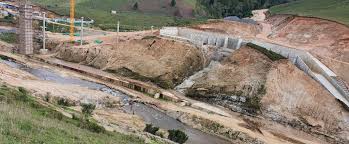
 Soyoi Muruny dam/ NWHSA
Soyoi Muruny dam/ NWHSAKenya’s water sector confronts serious challenges: widespread arid and semi-arid regions, climate change impacts, low per capita water availability, underinvestment and growing populations. Unpredictable rainfall, prolonged droughts and severe floods put additional pressure on limited resources. The National Water Harvesting and Storage Authority’s master plan projects a sharp rise in water demand by 2030, underscoring the urgency for bold and strategic action.
The plan prioritises water harvesting and storage infrastructure. Dams and reservoirs are not just engineering feats; they are lifelines for domestic use, industry and agriculture. Their role is central in ensuring water security and food self-sufficiency.
We have aligned our vision with global and regional development
goals – particularly the UN Sustainable Development Goals two, six and 13 –
emphasising food security, sustainable water use and climate resilience. Our
work also supports the African Union Agenda 2063 and the East African Community
Vision 2050, both focused on equitable resource management and poverty
eradication.
Locally, plan upholds the constitution, particularly the right to “clean and safe water in adequate quantities.” As a national agency, NWHSA is mandated to implement public water works for storage, flood control and drought response. These roles complement the water and sanitation responsibilities of county governments.
The targets are ambitious but clear. Under Kenya Vision 2030 and the bottom-up economic transformation agenda, we aim to boost national water storage by 125 million cubic metres by 2027. Major projects – like the Siyoi Muruny, Soin Koru, Bosto, Umaa and Badasa dams – will drive this growth. We also plan to promote household rainwater harvesting for 100,000 homes and construct 360 small dams and 203 boreholes to mitigate drought impacts. Flood protection through dykes and river training structures will further safeguard communities.
These efforts will significantly expand irrigation – covering 8,900 hectares – directly enhancing food security and reducing reliance on imports. They support the Ministry of Water, Sanitation and Irrigation’s target of achieving 80 per cent national water coverage by 2027, up from 60 per cent today. Water is a foundational enabler for Beta, supporting agriculture, housing, healthcare, MSMEs and climate action.
We recognise that infrastructure alone is not enough. Strong governance frameworks like the Water Act, 2016, and the National Water Policy 2021 are key to ensuring transparency, accountability and sustainability. We are committed to their full implementation.
This strategic plan is the product of careful research, internal and external analysis and stakeholder engagement. Drawing lessons from our legacy – the evolution from the National Water Conservation and Pipeline Corporation to NWHSA – we refined our priorities to focus on long-term water solutions and strategic drought response.
To implement this plan, we rely on our team of 172 skilled staff. We’ve established a robust performance framework, with clear annual work plans, evaluations and performance contracting. Our success depends not only on strategy but also on having the right people with the right skills. We are investing in capacity development and continuous training.
We are also prepared to navigate external pressures, from political and economic shifts to climate and legal dynamics. Growing urbanisation offers an opportunity for infrastructure expansion, though challenges like compensation delays and outdated equipment persist. We’re adopting technologies like GIS and green solutions to improve monitoring, efficiency, and sustainability.
Internally, our strength lies in our people, processes and
governance. We are committed to attracting top talent through competitive
compensation, a supportive work environment and professional growth
opportunities. Our operations teams and compliance units work together to
ensure sound financial management, legal integrity and responsive procurement
processes. Digitisation efforts are streamlining administrative functions and
reducing risks.
Operational efficiency is being reinforced through digital tools, refined HR practices, and a well-structured organization. Procurement follows the Public Procurement and Disposal Act, 2015, ensuring compliance and timely delivery of projects. We’re also addressing aging equipment through strategic maintenance and replacement to boost performance.
Through detailed environmental scanning, we’ve identified six key strategic issues: water harvesting and storage, flood control, data management, partnerships, financial sustainability and institutional capacity. These issues inform our six strategic goals:
- Increase water harvesting and
storage for irrigation.
- Reduce flooding impacts.
- Improve data availability for
better decisions.
- Strengthen partnerships and
collaboration.
- Ensure sustainable funding.
- Enhance institutional
effectiveness and service delivery.
To realise these goals, our strategies include expanding water infrastructure, boosting drought resilience, protecting lives and livelihoods, leveraging data and diversifying funding sources – including government support, donor partnerships, joint ventures, and commercial ventures via our Business Development Unit.
Monitoring and evaluation are central to our approach. We’ll track progress through site visits, stakeholder feedback and formal reviews, including mid- and end-term evaluations. Performance contracts tied to key results will ensure accountability and continuous learning.
At NWHSA, we are fully committed to building a water-secure Kenya. Through collaboration, strategic planning, and innovation, we believe this vision is achievable. We invite all stakeholders and Kenyans to join us in realising this shared future – because water is, and always will be, the lifeline of our nation.
The writer is the CEO, National Water Harvesting & Storage Authority











